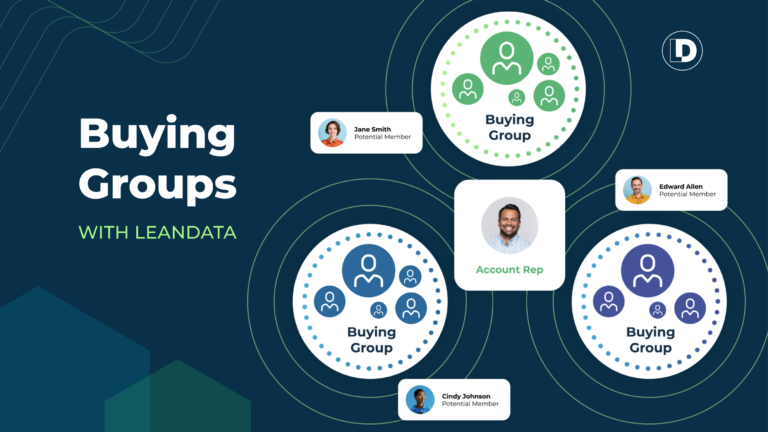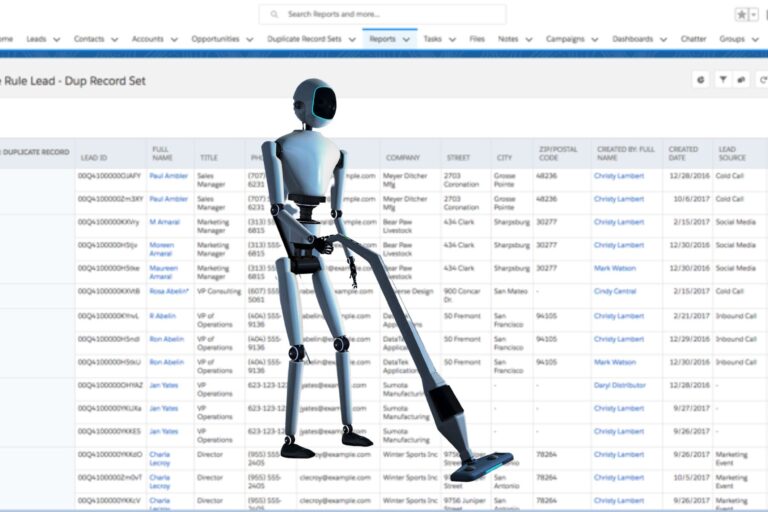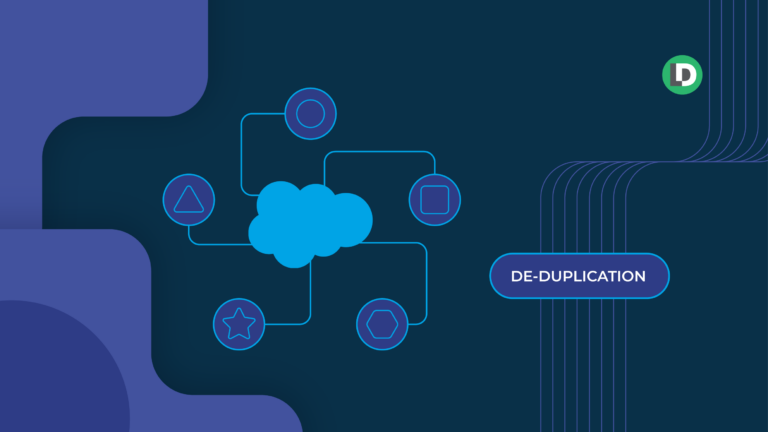B2B companies, whether in technology, SaaS, financial services, healthcare, consulting or something else, rely on Customer Relationship Management (CRM) platforms like Salesforce and Microsoft Dynamics to manage leads and customers.
Yet even with these powerful systems, data problems are rampant.
In fact, Salesforce’s own research found 91% of CRM data becomes incomplete, stale, or duplicated within a year.
Bad data isn’t just an IT nuisance. It has real business consequences.
Nearly half of companies estimate they’re losing over 10% of annual revenue due to poor CRM data quality.
When your sales forecasts, marketing campaigns, and customer insights are built on faulty data, the business suffers.
This article explores five common CRM data issues and exactly how each one hurts your business (with real examples and stats to prove it).
1. Missing or Incomplete Data
Nothing frustrates a sales or marketing team more than opening a CRM record and finding key information missing.
Unfortunately, this is extremely common. In fact, Dun & Bradstreet reports 91% of CRM records are incomplete.
Important fields like phone number, job title, industry, or even the contact’s country often get skipped. Sometimes customers don’t fill out every field on a form. Other times the sales rep simply doesn’t have time to input all the details.
So how does incomplete data hurt your business?
For one, it wastes precious time. Imagine a sales development rep (SDR) making calls but 20% of the lead records lack a phone number or have an outdated email.
Research shows that if an SDR works with 150 contacts a day and only 80% of those records are accurate, they’ll spend about 2.5 hours per day hunting down missing info or chasing bad contact details.
Across a full team, that lost productivity adds up fast.
Missing data also breaks your automation and personalization efforts. For example, if the “location” field is blank, your team might embarrassingly call a CEO at 5 AM their time or send an email with a {First Name} placeholder showing up instead of a name.
Incomplete records can even throw off lead scoring and routing. A lead missing a value for “industry” might not get assigned at all or could be scored inaccurately, causing sales to overlook a real prospect.
In short, when your CRM has holes, your team spends time plugging gaps rather than selling, and your prospects get a disjointed experience.

2. Outdated or Incorrect Data
Business data doesn’t stay fresh for long.
People change jobs, companies rebrand, phone numbers get disconnected and your CRM needs to keep up. Data “decay” is a persistent issue, with studies estimating that CRM data decays at a rate of 30–70% per year in B2B industries.
In other words, a huge chunk of those contacts and accounts you entered last year may now be outdated.
One B2B sales leader bluntly noted that reps often find themselves “sifting through outdated contacts” in the CRM, which leads to a lot of wasted effort on deals that no longer exist.
When salespeople are calling numbers that bounce to an ex-employee’s voicemail or emailing leads who left the company months ago, it’s not just their time being wasted, it’s lost revenue.
You might miss out on real opportunities because your database is cluttered with old info instead of fresh, reachable contacts.
Misleading Analytics
Outdated data also means your analytics are misleading.
Your revenue forecasts and pipeline health metrics get skewed by phantom deals and contacts that aren’t real anymore. No wonder finance teams often apply a “haircut” to forecasts, knowing some of the CRM inputs are unreliable.
The bottom line: old, incorrect data gives a false sense of your business. It can lead you to overestimate your pipeline (when half those “prospects” have moved on) or misallocate marketing budget chasing leads that are long gone.
Keeping data current is hard, but failing to do so turns your CRM into a graveyard of stale information and that drags down sales and marketing performance.

3. Duplicate Records

Duplicate data, like when the same company or contact appears multiple times in your CRM, is more than a housekeeping annoyance; it’s a serious business issue.
Duplicates typically creep in when data from different sources or departments isn’t properly integrated, or when users create a new record not realizing one already exists.
The damage this causes can be extensive. Internally, duplicate records wreck your single source of truth.
Information about one customer gets split between two or three records, so no one has the full picture.
One operations expert noted “when you have a duplicate problem, you can never be sure any record is the whole truth… teams constantly search the CRM for additional context.”
Externally, duplicates risk embarrassing communications and wasted budget. Marketing might unknowingly send the same campaign to a contact twice, or sales reps might each call the same lead, making your company look disorganized.
4. Inconsistent Data (Lack of Standardization)
Do you have multiple names for the same thing in your CRM?
For example, one rep enters industry as “Software” while another selects “Software & IT”, or there are five different values for the field “Customer Status”.
These kinds of inconsistent data entries are very common and very problematic. When data isn’t standardized, every team might interpret customer data differently and critical signals (like who is an active customer vs. a past customer) can be missed.
The business impacts of inconsistent data are often seen in reporting and targeting. If states or countries aren’t entered in a consistent format, territory-based assignments can fail because the system can’t match them to a rep’s region.
This leads to slow or no follow-up.
Similarly, if job titles aren’t normalized (e.g. one record says “VP Sales” and another says “Vice President, Sales” for the same role), trying to pull a list of all VP-level contacts for a campaign becomes a headache, and you might overlook some simply due to the mismatch.
Last, inconsistent data also undermines trust in the CRM. It fails to give a clear and unified view of customers. This can lead to misaligned efforts (marketing, sales, and service each seeing data differently) and even revenue loss, as important details slip through the cracks due to inconsistent labeling.

5. Siloed Data and Lack of Integration
A CRM like Salesforce or Dynamics is meant to be your “single source of truth” about customers, but that only works if it’s actually fed with all the relevant data.
In many B2B organizations, data ends up siloed across different departments or software. Perhaps sales lives in Salesforce, but the customer success team uses a separate system, finance has an ERP, and marketing relies on an automation platform.
These silos lead to each team working with their own version of the truth.
The result? Conflicting reports, misaligned strategies, and wasted resources
For instance, marketing might report one figure for “total customers” based on their email list, while sales has a different number in the CRM, creating confusion at executive meetings.
Silos also kill efficiency. A survey found employees waste 2.4 hours per day (30% of the work week) trying to find the right data across systems. Imagine the cost of that lost productivity across an organization.
Another real consequence is the rift it creates between teams. Sales might complain that “marketing’s leads are junk,” while marketing says “sales isn’t following up.” Often the root cause is poor data sharing.
Basically, if your CRM isn’t well-integrated and governed as the central hub, your teams will operate out of sync and your business will suffer for it.
Conclusion: Clean Data, Better Business
CRM data issues aren’t just technical annoyances. They have tangible impacts on revenue, efficiency, employee morale, and customer experience.
The good news is that the flip side is also true: solving these data quality problems brings real business benefits. Companies that invest in data quality and alignment see the difference.
It makes sense. When your sales, marketing, and service teams all trust the data, they can execute faster and make smarter decisions. Moreover, you stop hemorrhaging money on wasted campaigns and lost deals.
Analysts estimate that poor data quality costs companies an average of $12.9 million annually in inefficiencies and missed opportunities, so there’s a huge financial upside to fixing these issues.
The sooner you tackle these data pitfalls, the sooner your business can stop losing time and money to bad data and start reaping the benefits of a reliable CRM.
How LeanData Helps You Maintain CRM Data Issues
Addressing these CRM data issues might seem overwhelming, but there’s good news: automation can dramatically simplify the process. LeanData acts like a vigilant data housekeeper, ensuring your CRM remains clean, efficient, and accurate.
With LeanData’s Revenue Orchestration platform, businesses automate crucial aspects of data management, such as:
- Duplicate Prevention: LeanData automatically identifies and alerts your team to duplicate records, streamlining the cleaning process.
- Automated Data Updates: Keep your data accurate and timely by automating critical updates like contact roles and field enrichments.
- Efficient Lead Routing: Automatically match leads to accounts, route them correctly, and eliminate the inefficiencies of manual routing processes.
- Real-Time Alerts: Instant alerts via platforms like Slack or email help you quickly address data issues before they affect your business.
- Improved Data Flow: LeanData connects seamlessly with your existing tech stack, ensuring smooth data flow and reducing manual data maintenance.
LeanData empowers your teams to avoid data chaos, focus on high-impact activities, and deliver exceptional customer experiences, ultimately driving better revenue outcomes.
Investing in CRM data hygiene might not be flashy, but it’s one of the smartest moves your business can make. Cleaner data means less stress, greater productivity, and a healthier bottom line.










